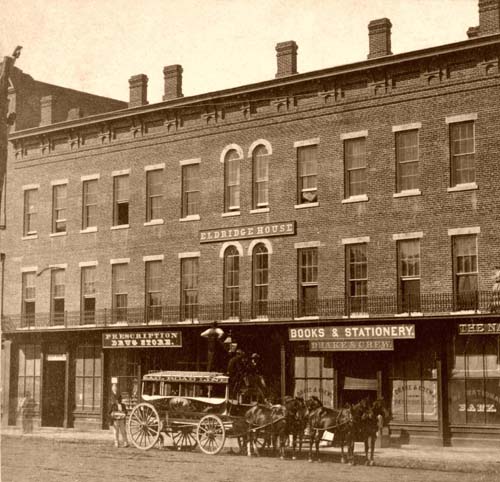When D.R. Anthony went to war in October of 1861, he left behind his budding journalism career, one that had in its short life already gained him notoriety as one of Leavenworth’s most outspoken and adamant voices.
His achievements as a journalist would eventually bring him fame equal to that he achieved on the battlefield, and would also make him one of the most influential people in Leavenworth. As is true with many stories about D.R. Anthony, it began with a fortuitous stroke of luck when D.R. Anthony partnered with friend D.W. Wilder to enter the newspaper business. On January 28, 1861, Anthony and Wilder established the Leavenworth Conservative, with Anthony as publisher and Wilder as editor. The very day after the Conservative was founded, news arrived from Washington D.C. that the Territory of Kansas had been accepted into the Union as a free state under the Wyandotte Constitution. Anthony seized the opportunity, riding to Lawrence, the epicenter of the Free State movement, (and where the telegraph line did not reach) and presented issues of his newspaper to members of the Free State Legislature at the Eldridge House Hotel. The Eldridge, pictured above, is still in operation, though it is not the original structure. A powerful symbol of the Free State movement and Jayhawker headquarters, it suffered multiple attacks between 1855 and 1865 by Confederate guerillas who sought to destroy it. It is also reported to be haunted.
Anthony himself would recall his dramatic entry to the field of journalism 25 years later, on the 25th anniversary celebrations of Kansas’ admission. Speaking as the President of the recently created Kansas Historical Society, Anthony said “it was my privilege, twenty-five years ago today, to carry on horseback from Leavenworth to the territorial legislature then in session at Lawrence, intelligence of the admission of Kansas to the Union.” Not a man of modesty, Anthony reveled in his accomplishment.
As a journalist, Anthony brought the same straight ahead, no-nonsense approach that characterized the rest of his life. He stuck to his morals, and when he felt someone had misrepresented him or insulted him, he was quick to respond. In this respect he was like many of his contemporaries in the field. In an environment where the wounds of Bleeding Kansas were still fresh, this was an explosive mix, one that came to a head in June of 1861, shortly after the Civil War began. On June 3rd, a detachment of the First Kansas Infantry captured a Confederate Flag in Iatan, MO and brought it back to Leavenworth as spoils of war. The Conservative and other area papers endorsed the act. The White Cloud Chief trumpeted their bravery in an act that was not part of an official operation, but was done “on the sly.” After Anthony wrote a supportive article, Kansas Herald publisher R.C. Satterlee wrote and article of his own on June 13th, in which he accused Anthony of being a liar and possibly a coward. I say possibly because accounts of Satterlee’s article differ, and I have been unable to locate the article itself. Whatever it was that Satterlee said, it infuriated Anthony, who met Satterlee in the street and demanded a retraction. Satterlee refused, and both men drew their revolvers. Accounts differ over who fired first; The Oskaloosa Independent says Anthony fired first, but W.W. Admire’s account in his biography of Anthony says it was Satterlee who fired first. The White Cloud Chief does not specify. Similar differences exist over the quantity of shots. Whoever it was that shot first, Anthony had better aim, hitting Satterlee, whose own shots went wide and apparently injured a bystander. Satterlee died where he fell, and Anthony was charged, and eventually acquitted.
Anthony’s move to join the fraternity of newspapermen marked a seminal moment in his life. His military star, for all its brilliance, burned very briefly. As a newspaperman he would become one of the most respected and controversial figures in Kansas and his career would span nearly the rest of the century. He would also continue to get himself into trouble, and this would not be the last time one of Anthony’s quarrels in print led to a bloody confrontation.
Sources:
Admire, W. W. “An Early Kansas Pioneer.” Magazine of Western History 10, no. 5 (1889): 16.
Connelley, William Elsey. A Standard History of Kansas and Kansans. Chicago: Lewis, 1918.
“Leavenworth, June 13.” White Cloud Kansas Chief, June 20, 1861.
“Shooting Affray.” The Independent, June 19, 1861.

